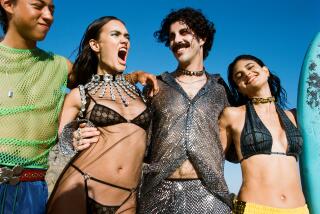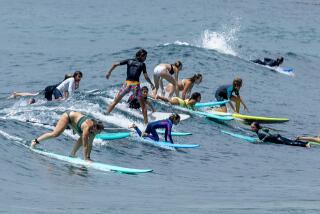Dale Velzy, 77; Master Surfboard Shaper Helped Popularize the Sport
Dale âThe Hawkâ Velzy, the pioneering master shaper of surfboards who helped popularize the Hawaiian sport of surfing along the California coast, has died. He was 77.
Velzy, a longtime smoker, died of lung cancer Thursday at Mission Hospital Regional Medical Center in Mission Viejo.
âI canât tell you strongly enough how he was the original surfer-cowboy-hot-rodder in Southern California,â said Allan Seymour, who had known Velzy since the eighth grade and now produces a vintage surfboard and memorabilia auction. âWhen we grew up, you couldnât get a higher compliment than, âYouâre a Dale Velzy guy.â â
A pioneering surfer off Manhattan and Hermosa beaches, Velzy was the first to put a brand on his boards, establishing him as surfingâs first commercial shaper or builder.
His most famous board, the Pig, hit the waves in 1955 and is now a collectible -- what Velzy called âwall hangers,â priced at more than $3,000 each. Another Velzy specialty board was the Bump.
In 1960, when he ran five shops and two factories and sold up to 200 boards a week in the made-by-hand industry, Velzy was considered the worldâs largest surfboard manufacturer.
Born in Hermosa Beach on Sept. 24, 1927, Velzy started hopping on older surfersâ boards as a tyke, and by age 8 had acquired his own surfboard, carved by his father, a lifeguard and dory builder. With the woodworking tools of his cabinetmaker grandfather, Velzy and his dad started shaping boards.
âI got into building boards like that,â he once told surfing historian Craig Stecyk, âshaping down old planks into smaller, lighter boards I could use.â
Over the years, Velzy would adapt his technique as boards changed from wood to polyurethane foam and from long to short and back again. He shaped boards for such legendary surfers as Duke Kahanamoku, George Downing, Mickey Dora and Harry Robello.
Nicknamed The Hawk -- as he would carefully explain, it was for his keen eyesight, not the shape of his nose -- Velzy served in the merchant marine during World War II and then worked as a lifeguard.
He began repairing and reshaping surfboards commercially in the family garage in 1949 and soon set up shop at the Manhattan Beach Surf Club under the Manhattan Beach Pier. He took his itinerant business to Venice and then Hermosa Beach, where in 1953 he joined Harold âHapâ Jacobs to produce custom boards under the Velzy-Jacobs label until he bought Jacobs out in 1959.
âCustom builtâ was a term of art for Velzy. Although he designed boards to order, if the customer was late on pickup day, Velzy thought nothing of selling that board to anybody who showed up with money. The original customer would also get a board that made him happy, if not the one designed for him.
Velzy would also engage in inventive measuring, performing tricks with a tape or a yardstick to convince a buyer who wanted a 9-foot-2 board that a 9-foot-6 one was exactly the length specified.
âVelzy has always been fast and heâs got loads of style,â Jacobs says in Malcolm Gault-Williamsâ book âLegendary Surfers.â âDale is the greatest salesman in the world.... Once he even sold my own personal board.â
Style he had, all right: Velzy drove glamorous cars, dated beautiful women, sported tattoos, slicked-back hair and a handlebar mustache, wore diamond rings and smoked expensive cigars. He earned his âcowboyâ reputation by working on ranches, developing skills in saddle making and leatherworking, and later decorating his San Clemente house in western style. He liked riding horses as much as driving the cars -- and, later, motorcycles -- that tagged him as a hot-rodder.
In 1956, with his business booming, Velzy befriended young surfer and photographer Bruce Brown, whom he had hired to sweep up the shop. In a typical demonstration of his generous, visionary mentoring, Velzy helped launch the surfing-movie genre by giving Brown $5,000 to buy camera equipment and fly five surfers to Hawaii to shoot his 1957 film âSlippery When Wet.â
Brown made more surfing documentaries, including the commercially popular âThe Endless Summerâ (1966) and its 1994 sequel, âThe Endless Summer II,â which further increased surfingâs popularity. Other filmmakers followed. Hollywood jumped on the bandwagon with âGidgetâ (1959) and a series of lighthearted beach movies.
Velzy may have been an innovative craftsman and stylish salesman and surfing promoter. But a businessman he was not. When his manufacturing operation peaked in 1960, about a year after he bought out Jacobs, officials came down on him for unpaid taxes. His shops were padlocked and most of their contents auctioned.
Near financial ruin, Velzy continued to shape boards -- but as an employee of others, including Hobie Alter in Dana Point. Velzy taught youngsters the craft in his Surfboards by Dale shop in Newport Beach, and eventually made Velzy boards again, working in his own backyard.
The colorful surfer personally preferred longboards and made them for adult surfers. But by the 1960s, Velzy began making shorter boards and paddleboards to encourage more children to take up the sport.
âYou couldnât even sell a board in the â60s unless it looked like a Velzy board,â fellow shaper Joe Quigg says in âLegendary Surfers.â âWhat Velzy did all along the Strand, from Hermosa to Manhattan and Redondo, was get all the little kids who wanted to surf onto his small boards.... By doing so, he really popularized the sport. He was the first guy to sponsor surfers, the first guy to advertise in a big way, and the first guy to put surfboards -- and thus surfing -- within reach of the average kid on the beach.â
A mentor to a generation of young surfers, Velzy had an even greater influence on those who followed him into the surfboard business.
âDale is the master of wood,â Steve Boehne, owner of Infinity Surfboards, said in an online tribute to Velzy posted at the Shapers Tree. âHis combination of wood color and thickness of stringers are unique and stunning. His wood boards are a treasure, he is a treasure, a great innovator and a master shaper with a great sense of humor and a warm heart.â
In 2003, Velzyâs name was placed on a plaque along with those of the six other charter members of the Hermosa Beach Surfers Walk of Fame: Jacobs, Bing Copeland, Greg Noll, Mike Purpus, Rick Stoner and Dewey Weber. Six years earlier, Velzy was added to the Huntington Beach Surfing Walk of Fame as a âsurf pioneer.â
Velzyland, a popular surfing spot on Oahuâs fabled North Shore, is named after him.
In 2000, the Doheny Longboard Surfing Assn. named its annual surfing contest in his honor.
âAll Iâve tried to do is to have fun and do whatever it was as good as I could,â Velzy says in âLegendary Surfers.â
Twice divorced, Velzy is survived by his longtime companion, Fran Hoff of San Clemente; a son, Matt of Makawao, Maui, Hawaii; and a daughter, Malia Cohen of Thousand Palms.
Services are pending.


